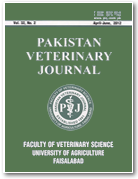VETERINARY
JOURNAL


- Home
- Editorial Board
- Archive
- In Press Articles
- Author's Guide
- Submission
- Subscription
- Top 10
- Contact us
|
||||||||||||

ISSN 0253-8318 (Print)
ISSN 2074-7764 (Online)

|

|
 |
|
PAKISTAN
VETERINARY JOURNAL   |
||||||||||||||||||||||||||||
|
| 
ISSN 0253-8318 (Print)
|
||||||||||||||||||||||||||

|

|
 |